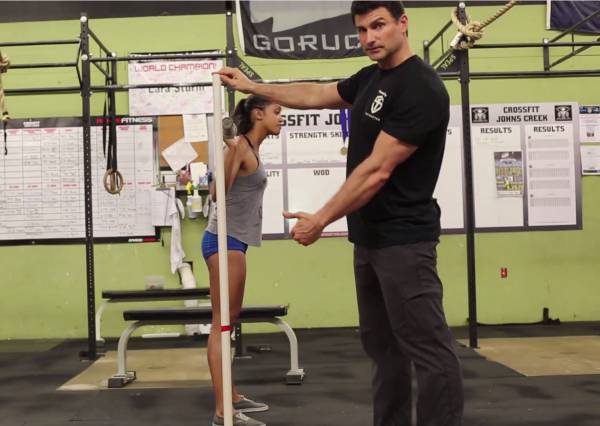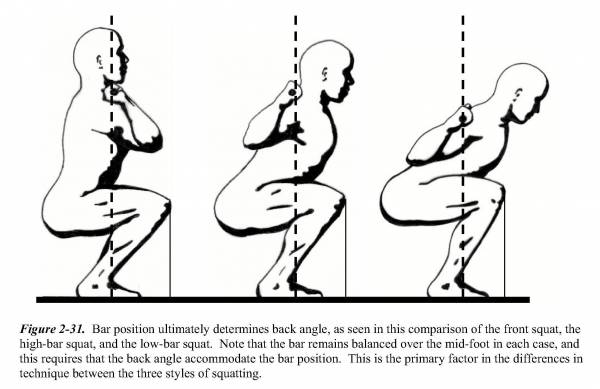If your program contains many front squats, Olympic movements, and wall balls, you might want to add in low-bar back squats and hinge movements to stay balanced.
The front squat and its variants emphasise the anterior (thigh) muscles, while the low-bar back squat and hinge movements (deadlift, kettlebell swing) emphasise more of the posterior (hamstrings, glutes) muscles. Let’s take a look at why this happens and what exercises you need to keep yourself balanced.
Bar Position Determines Hip Angle
In any movement, the weight is pulled down by gravity in a straight-line path to the ground. Our bodies move around this path. For example, when we get up from a sitting position, we lean forward to counterbalance the weight in our hips (try to stand from a sitting position without bending forward; it is harder than you think). So, any time we add weight to our body, we balance it out along this imaginary line to the ground.

Any time we add weight to our body, we balance it out along this line to the ground.
In the front squat, we keep an upright torso, as that keeps the weight following our imaginary line to the ground. In a low-bar back squat, we bend forward to keep the weight along this same line.

Mark Rippetoe in Starting Strength has a great discussion about angles and lever arms in the squat and deadlift.
What Muscles Work More?
Squats of any type will use many muscles in the legs. However, the angle of the back changes the emphasis of which muscles do the most work.
“Many CrossFit-style programs overemphasise thigh-dominant exercises, such as front squats (in the Olympic lifts) and wall balls.”
The most basic example is a stiff-legged deadlift or good morning. In this exercise, the legs remain stiff and the upper body bends at the hips. The glutes and hamstrings do most of the pulling to bring the upper body upright. Thus, this movement almost exclusively focuses on the posterior muscles.
At the other extreme, we have a leg extension machine. When using this machine, the knee goes from a bend until it is straightened. The thigh muscles are dominant and are used to pull the lower leg into the straightened position.
More Hip Hinge = More Glute/Hamstring Activation
Putting together the above information, we can see that:
- In the stiff-legged deadlift, our posterior muscles are levering our back upward in the movement. Low-bar back squats are going to use more of the posterior muscles, as this movement requires levering our back into the upright position.
- The higher the bar (or if it is in the front squat position), the less we need to lever our back, and we will have more thigh muscle involvement to straighten our leg (similar to the leg extension machine).
Summary
Many CrossFit-style programs overemphasise thigh-dominant exercises, such as front squats (in the Olympic lifts) and wall balls. So, remember to use hip hinge exercises as well to balance out the upright torso squat exercises. Deadlifts, low-bar back squats, and kettlebell swings are a great way to utilise the posterior chain.
Further Reading:
- Front Squat Versus Back Squat: Which One Is Best for You?
- Squat Therapy: 4 Drills for a Better Squat
- A Primer on Front and Back Squats
- New on Breaking Muscle UK Today
Photo 1 courtesy of CrossFit Impulse.
Photo 2 courtesy of Craig Marker.
Chart From Starting Strength, Copyright 2008, The Aasgaard Company. Used by permission.






